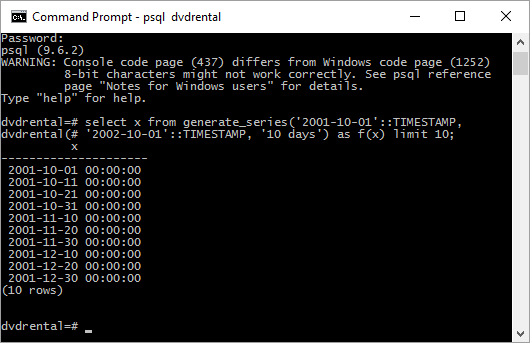PostgreSQL Advanced
This post is continuation of the series. If you do not have Postgres on your machine or sample data, you can read Installing PostgreSQL and Loading Sample Data post first.
There are functions like date_gt to compare date types.
1
2
select * from payment
where date_gt(payment_date::date, '2007-04-01'::date);
You can use date_part to get a part of datetime.
1
2
3
4
select amount, payment_date, date_part('quarter', payment_date) as quarter,
date_part('year', payment_date) as year, concat('Q', date_part('quarter', payment_date), '-',
date_part('year', payment_date)) as display_quarter
from payment;
generate_series(start, stop, step) generates a series of values, from start to stop with a step size of step. We need a function like f(x) to get the value. If we use a negative number as step, it will be decreasing.
1
2
3
select x, md5(random()::text) from generate_series(100, 0, -5) as f(x);
select x from generate_series('2001-10-01'::TIMESTAMP, '2002-10-01'::TIMESTAMP, '10 days') as f(x);
1
select trunc(random() * 1000 + 1) from generate_series(1, 1000);
Let’s use this series in an example;
1
2
3
4
5
6
7
8
9
10
11
12
13
14
15
16
create or replace function random_payments(counter int) returns setof payment
as $$
DECLARE
start_id int;
end_id int;
BEGIN
select min(payment_id) from payment into start_id;
select max(payment_id) from payment into end_id;
return query (select * from payment
where payment_id IN(
select trunc(random() * (end_id - start_id) + start_id)
from generate_series(1, counter + 1)));
END
$$ language plpgsql;
select * from random_payments(100);
If you have large and complicated queries, you can use WITH query to make it easily readable. These statements often referred to as CTE (Common Table Expresssions). The subquery also generates a tsvector to query but I have already mentioned that before it is a bad practice.
1
2
3
4
5
6
7
8
9
10
11
12
13
14
with actor_rollup as (select f.film_id, title, sum(p.amount)::money as total_sales,
group_concat(first_name || ' ' || last_name) as actors,
to_tsvector(concat(f.title, ' ', group_concat(first_name || ' ' || last_name))) as search_field
from film f
inner join film_actor fa on f.film_id = fa.film_id
inner join actor a on a.actor_id = fa.actor_id
inner join inventory i on i.film_id = f.film_id
inner join rental r on r.inventory_id = i.inventory_id
inner join payment p on p.rental_id = r.rental_id
group by f.film_id, title)
select title, actors, total_sales
from actor_rollup
where search_field @@ to_tsquery('jedi');
We can use CTEs with Views together but they are different. CTEs are disposed when the query is done. Views are database wide and can have permissions. CTEs can be recursive.
1
2
3
4
5
6
7
8
9
10
11
12
13
14
15
16
17
18
19
20
21
22
23
24
25
26
27
28
29
30
create view raw_sales as
select title, description, length, rating, p.amount, payment_date,
date_part('quarter', payment_date) as quarter,
date_part('month', payment_date) as month,
date_part('year', payment_date) as year,
concat('Q', date_part('quarter', payment_date)::text, '-', date_part('year', payment_date)::text) as qyear,
cash_words(amount::money) as spelling_it_out,
to_tsvector(concat(title, ' ', description)) as search_field
from film f
inner join inventory i on i.film_id = f.film_id
inner join rental r on r.inventory_id = i.inventory_id
inner join payment p on p.rental_id = r.rental_id;
with sales_rollups as (select distinct title, qyear,
sum(amount) over (partition by title, qyear) as "Quarterly Sales",
sum(amount) over (partition by qyear) as "Total Quarterly",
sum(amount) over (partition by title, qyear)/sum(amount)
over (partition by qyear) * 100 as "Percent of Total Quarter"
from raw_sales
order by title),
q1_2007 as (select * from sales_rollups where qyear = 'Q1-2007'),
q2_2007 as (select * from sales_rollups where qyear = 'Q2-2007'),
things_are_correct as (
select
(select sum("Percent of Total Quarter") from q2_2007),
(select sum("Percent of Total Quarter") from q1_2007)
)
select * from things_are_correct
We will continue with NoSQL features of PostgreSQL next time.
